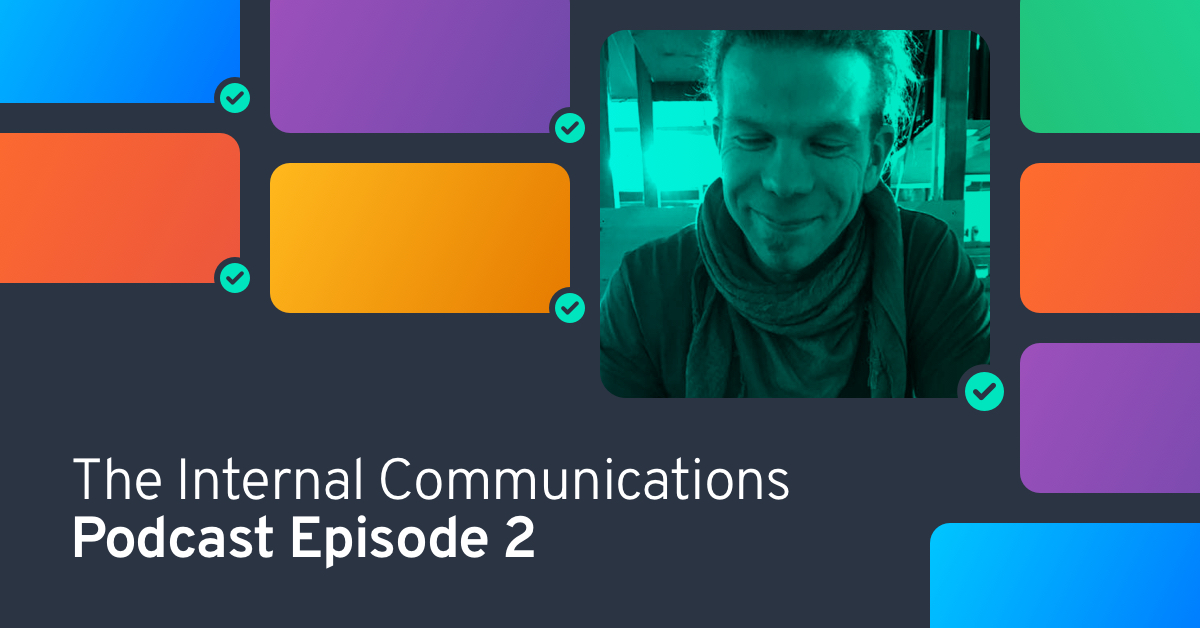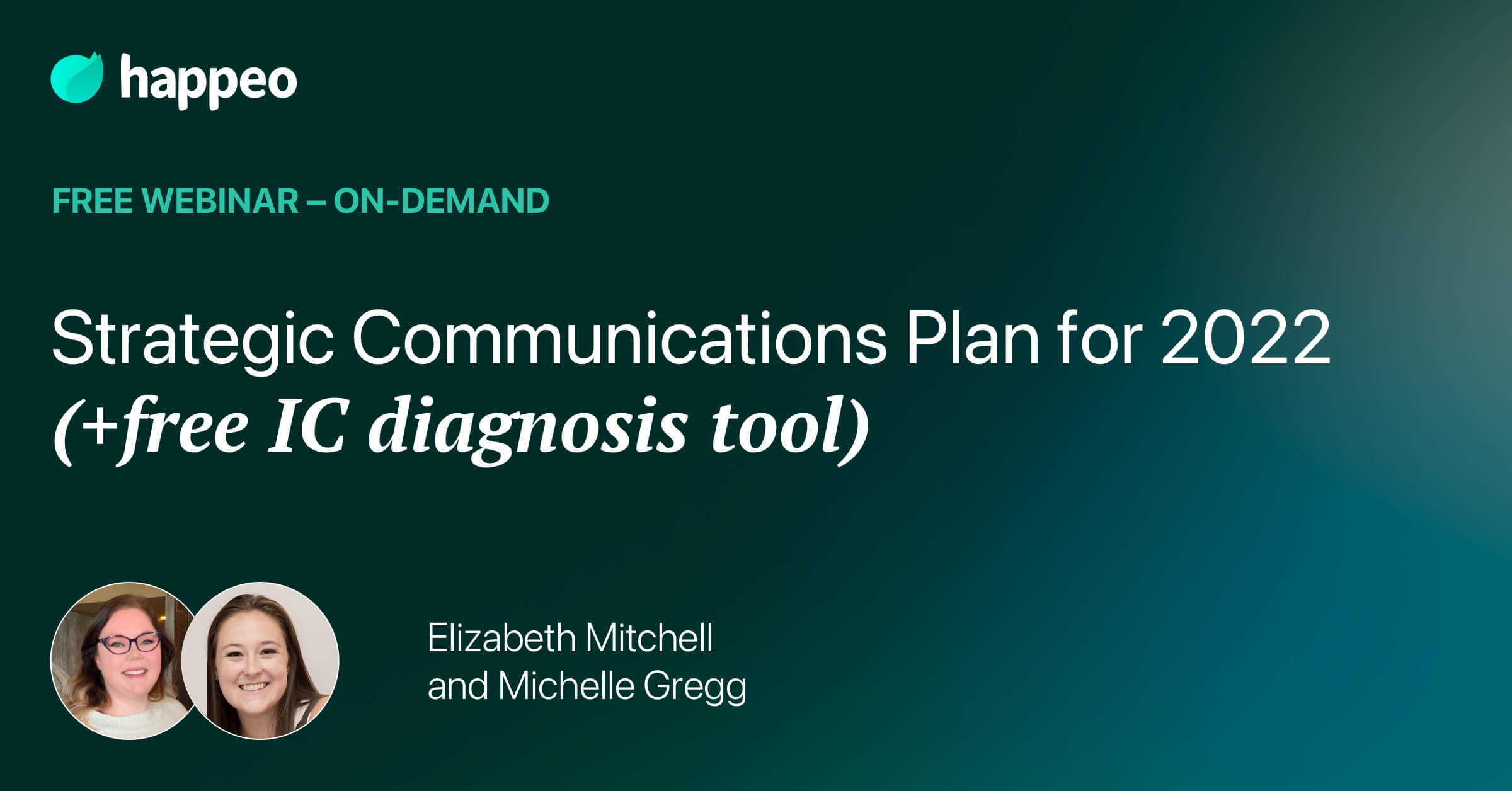

Internal Communications
Podcast: Research proves need for UX in Internal Communications

Jonathan Davies
19 mins read
Tue, Feb 12, '19
Internal Communications is evolving. Research showed that it’s been stuck in the same rut for the past 20 years, but Mike Klein’s second report signals this is about to change.
“The end of the beginning” focusses on the near-term future of Internal Communications – its convergence with PR, the importance of employee advocacy, gaps in profession maturity and practitioner skill level and lastly, the efficiency and effectiveness of messaging. And exactly that topic is why the field of User Experience (UX) design has so much to teach Internal Communications.
Listen on Apple Podcasts | Spotify | Stitcher | RadioPublic | CastBox
Who's Dan, and what does he do?
Today we have a special treat for you. Here to help us figure out what Internal Comms can learn from UX Design is Dan Williams, senior UX designer at within reach group, one of Europe's fastest-growing telecommunications and tech companies. Dan has a degree in the earliest form of UX design and a Ph.D. in the field of augmented reality for science education at the University of Birmingham. He arrived in the Netherlands in 2007 after a spell, at the Technical University of Delft. He stepped away from academia to work in the world of mobile and web-based interactive applications and telecommunications. I consider him the absolute authority in the field of human to technology interaction, and we as Internal Comms people have so much to learn from it.
This is also highlighted in my client's second research. This shows us that I see people need to be more aware of our messaging methods. We're going to look at what Internal Comms can learn from user experience design, how technology can help us make our messaging more efficient, and what we should really pay attention to, next to the content.In the end, we're going to get down 60 seconds to define the three key points that every Internal Comms person should know when designing messages to their audience. Dan, I'm so excited to have you here, welcome. UX design is a field that's becoming increasingly popular. I'd say there's a boom in the job market for it right now, and it's also a field that touches upon communication lots and deals with human interaction.Can you explain to our audience what a UX designer does?
Dan Williams: Sure. First, I’m very happy to be here. UX has always been here. It just didn’t have an identity as it has now. I think it comes from a long field of studies in human performance. Psychology, cognitive science, this kind of thing. It wasn't the economics of course. So there was a big boom around the nineties of crazy looking miles, you know, screens and so on.What really popularized it was a lot of literature coming out, especially on the web. One of the books that really inspired me was The Design of Everyday Things. That's by Don Norman. He does a lot of work for Apple nowadays. That book really took everyday objects and he talks about why it's intuitive to use. What really makes that product liftable, tiltable. You introduced the word cord affordances. So this chair has got certain affordances. It kind of invites you to sit. It doesn't invite you to do a headstand or press or push it around. It’s specific.
Jonathan: Right? So it's designed around what we believe we'll do.
Dan Williams: Yes. A lot of people took that to a certain extent as the path of least resistance or, you know, don't make me click twice when I can click once.That's not strictly true. Nowadays, a lot of people use products because they enjoy doing things. They like to engage, they like to explore. So it's not really about the minimum number of clicks. It's really about the journey to get to your destination in the most satisfying way. Maybe efficiency is effective, maybe enjoyment is effective.Effectively it has this purpose in the best way.
Do we have your attention?
Jonathan: My client is doing research for us, and his second report is now at the time that this releases its life. Dan, I'm going to photo quote you from the report and I'm interested in hearing what you feel about this.“There are decreasing attention spans. Employees are increasingly conditioned to snack on content and get what they want instantly and easily.”
Dan Williams: It's an interesting one. I think you need to break it down into its component parts. I think it's quite a bold statement to say that our attention spans are decreasing. We didn't evolve over millions of years just to devolve into the latest 30 years because we've interacted with machines.I think it's more about being bombarded with lots of content, lots of agency, lots of channels, and humans are not really great at making choices. So this is one of the issues. It's about making things filtered and relevant to you. One of the topical things at the moment is the verification of sources. Is it clickbait or is it an actual story? A lot of people put a lot of trust either in institutions, such as journalism or their peers, their friends. If I know that you or other peers have read that, they'd give it five stars, thumbs up. I'm more inclined to trust that source too. These types of channels or these types of content should maybe prioritize a little bit better. Also the relevance - is, is it relevant to what I'm doing now? Is it something I can read later? Not everything needs immediate attention - it can be put off to another date, could be shared - but then, I think about that second part of the quote. Yes, everything is being built to accommodate this assumption that everything has to be snackable, consumable, quick. You just see a lot of sensationalized titles, a lot of SEO based writing. That's basically just trying to get as many eyes on the article and not really pushing the message. I think some of the content does suffer when it comes to that. That also allows really good content to stand out.That will, at least I hope, prevail in the end. Not everybody would just be conditioned to the lowest common denominator, but I still appreciate substantial articles.
Jonathan: We're also kind of seeing that for example Google is focusing more on quality of content, rather than keyword density and on these types of things. I think for the internal communicators out there is kind of good news, because they've never had to optimize content towards their company on an SEO basis.So you're saying that quality of content is going to be the most important in the end because that’s about the journey to satisfaction.
Dan Williams: Yeah, for sure. There's a lot of factors that come into what you deemed quality. It's also a very personal thing. What you deemed to be quality might not be what I deem to be.It's really about knowing who the user is, and either channeling or customizing that context or that user. I don't think there's a single piece of content that's universally accepted. Content is king. It's not just a tagline that's used loosely. It really is. I think adding onto the content, context is also ok. You need to know which devices people are reading these articles from. Obviously your mobile phone is more snackable media. If you want to read a long article, then you're going to go to a tablet or a desktop. So you need to think a little bit, maybe the timing of the day. The location is where people are in the office. They probably don't want to see memes all day. Maybe out of the office, it’s acceptable. Maybe it's a team-bonding thing. Yeah. It really is a matter of fitting the content to the audience. That's not a new idea, but it's a different way of interpreting it.
Curate, don’t moderate
Jonathan: I think that saying content is king is definitely preaching to the choir. I think Internal Comms people love hearing that. A lot of us come from a journalistic background. I think the issue of context around it is a really interesting point to make.I think that organizations, in a lot of new ways of communicating and of organizing, will start to become increasingly more agile. A lot of organizations will promote a bottom ups communications approach. So when that approach comes, do you think they need to find a way to make sources with higher credibility, more visible, or should we start moderating what's being said on our enterprise social networks more?
Dan Williams: First off, I think moderation is quite a strong term. I prefer the word curation because moderators give the impression that certain content is going to be blocked or diverted away. What is curated, who the user base is. Maybe they have some categories, topics, tags that they're interested in, so then it reaches them.I think that it's more of a pull strategy. That's what we mean by bottom-up rather than top-down. it's quite funny if you look in any office, I suppose our office is quite typical. We use so many communication folks, whether they're official or unofficial, it doesn't really matter. But it's quite funny how you see people latch on to specific tooling. For example, it's quite often that I will sit next to the UI designer. We don't speak a hell of a lot during the day. but we Slack all day, and most of that is an asynchronous conversation. What does that mean? Well, if I go in separately on the show and ask her a question, I'm interrupted.It's not just computers that are interrupting our attention spans, it’s also people. I also like to have a backlog of notifications of, okay, I can deal with that when I've got time, when I've got a coffee break. So platforms raise it up a little bit the urgency of certain channels, so you react to them quickly.That's how you design your kind of environment. There are other people that don't use any tooling, so you have to shout across the office to them.
Jonathan: And the corporate megaphones.
Dan Williams: Yeah, we've got a few names for those. It's really down to the individual. We've adopted a holacracy kind of system, which is a bottom-up, self-organizing structure. You still see some of the old mechanisms from departments. They usually have a WhatsApp group, so they use that for days out, or reporting illness. It’s kind of an accepted but informal mechanism that those departments use, even though those departments don't really exist.That this is a kind of a bottom-up way of doing things as well. I mentioned spark before. That's a good example because there is no real structure, there are no teams. Channels emerge based on a topic - it could be fleeting, it could be for a day, it could disappear. Sometimes it gains momentum and when you use it every day, that’s the kind of, evolving organic structure that I would encourage in all internal communications. Top-down structures try to force people to use it in a certain way.Some people really enjoy it, but it will force a lot of people out because it's not relevant to them. That would mean being bombarded by notifications that they don't want to see. It will just push them to another platform. And yet, interestingly, a lot of people get really attached to the emotional way.
Jonathan: In what way?
Dan Williams: Well, a good example is that we build unified communications. It was quite interesting when I caught up with you after. The time had passed. and you told me about happier internal communications, and you use this word internet, that word, when it triggers me, I think these nineties old, you know, horrible systems or SharePoint or, you know, WordPress, just simple CMS is.So it was quite nice just when I saw the interface of it. It looks like any social media platform. But it's giving you the content from your organization, in a nice, digestible way. So I never really thought that team collaboration, unified communications, intranet, are all part of the same thing.They’re marketed or positioned in a different way. Right. The core mechanisms, it's usually based around chat, video and audio
Efficient UX for effective communications
Jonathan: There was another quote in my client's research from the second report that came out that I'm interested in hearing your view on as well.So every time we give employees communication, we give them a problem or a decision they have to make. We need to reduce the number of nonessential decisions they have to make. And I think this ties very much into a two-part article that you wrote on LinkedIn, and the field of UX design in general.You touched upon creating a path of least resistance, or of most enjoyment in a way. How can we as internal comms professionals make sure that our messages are effective and efficient to our audience?
Dan Williams: It's really strange the way you use it in channels with certain people or certain topics. a few examples. I don't know if you've ever done remote job interviews. You probably always use Skype or Google Meet. So it's kind of ingrained that that is the first choice. Go for it. Unless it's a specific need. If you have to do certain screen-sharing, then you'll probably use a different mechanism. For many years, Skype was also the only thing that my mother could get into her head, and I had to set up their account and I had to put my address in there. But then I'm just one click away and she could get that. She couldn't really translate that to other applications. She didn't really feel the need to, but Skype really became the verb for video call. Until a lot of others joined the party. but then again, there are lots of examples like that. Sometimes I choose my mechanism, whether I want to know whether somebody is going to read the article, read the message.So if it's a time-critical situation, maybe I'm in the supermarket shopping. I need to know which product to buy. I'll use WhatsApp because then I can know whether my wife or whoever has read it and responded. If you send an iMessage or SMS, you don't get that feedback. So sometimes it comes back to context, what you want, what's the lifetime of this conversation.In fact, it's into a lot of things.
Applying the UX mindset to Internal Comms
Jonathan: Another thing that I find really fascinating about the field of UX and the boom in it, is that you've now got a job title called UX writer. I sold this on LinkedIn the other day and I found it really interesting. So companies like booking.com and several really innovative agencies are hiring specifically for that.What do you think a UX design mindset brings to the professional Internal Comms? Where, as we said before, a lot come from a journalistic background.
Dan Williams: If you positioned it again as SEO writers or technical writers, I think UX really brings a kind of a friendly approach to the interaction.A lot of interfaces, they're more conversational now. You can really see the character of a company come out in their content. A few examples would be the first time I ever noticed it was, the Twitter fail whale. Right. It's an error message. It's great. I cannot do what I came here to do, but they make a friendly whale and they say, oops.You know something went wrong. So that was one of the first examples I really noticed, and I thought it was a nice, It's a nice part of the UI. A few other examples would probably be a MailChimp. MailChimp, that always comes to a point where, okay, I'm going to push this button and it's going to hit 50,000 people. Plus, so it's usually quite a nervous moment, but you've got this, you know, silly Chimp running around, giving you advice, are you sure? Giving you a thumbs up, and then once you click send, you get a big high five. Yeah, because it's done and there's nothing else you can do about it. It promotes more informal dialogue with the user.They're more inclined to use it again and come back. They had a good experience. Another awesome example would be whenever you get an update from Slack, you get these nice informal notes. So it's not like we implemented this feature, we did this, we did that. There's no books. It's more like, yeah, we cleaned out the gremlins in the notification center. We have this sparkly new logo. Don't you think it's cool? but I liked that informality, and I think that draws a lot of people into the company, and it keeps them on so that cause they get used to it. As soon as you move away from this kind of thing, you really notice it. If you go to another newsletter provider and you don't get that high five, yeah, you're going to be a little bit upset.
Jonathan: So do you think that kind of informality for Internal Comms people is something they can take that into their company, to their communication? Does that work across every company?
Dan Williams: It wouldn't work across every company. I’m not big on the enterprise community, and that's a different animal altogether.Going back to the, okay, I'm promoting bottom-up. But sometimes you need a top-down structure. Otherwise, you really can have too much tooling, too much fragmentation. And that also doesn't help. If you look at what IBM has done, they've reinvented themselves. They're a big enterprise company, and they've come across really innovative, informal, bright, colorful.If you look at their advertising and even touching on big topics, like AI. I saw an article yesterday, or page advertising-free sign up, and that was also very informative. Very inviting.
Jonathan: Yes, you’re really right about IBM. One of the things that I saw is, well, the person who trained me to be a writer, essentially, she also wrote a series of articles on the security people in IBM, and she had said she had a really fascinating take on this because security is seen traditionally as this really kind of boring corporate thing. You know, take the books, you need to have this, but actually what these people do is super important.So what do security experts do, what are they like in real life? What makes them tick? What gives them a passion for what they do essentially? I found a very kind of organic way of storytelling. Like I remember she wrote one article in particular about a cybersecurity expert who also worked in the Israeli defense force. He used to dismantle bumps, and he likened a cybersecurity attack to dismantling a bomb, which made everything a lot more relatable to people, but also the company itself potentially. So I think that from what I gather from what you're saying is that maybe it’s not necessarily informality that we need to pay attention to, as much as translating what we do into simple language. I think that might be a nice UX thing. Simple, as in beautiful in a large part of what you do. Correct me if I'm wrong.
Dan Williams: For sure. It always ties back to the audience. If you're looking for a messaging platform, or a communication platform for a specialist niche such as this, if you think of the emergency services, you can't really imagine a police officer or a fireman slacking in the middle of work.They still stick to one way, or maybe, a bottom-top to say they've acknowledged a telegram message. It's usually one way. What you see in a fire engine is just a message that says you have to go to this location, and you just have to hit a button that says you've acknowledged him. It's that simple because that's all they have to do. They don't have to respond in any other way. They don't have to take the gloves off and start typing. We actually did a nice experiment when I was back at university on how-to guide and navigate firemen in a fire. So you wouldn't want a touch screen. We even considered augmented reality, but that's not great in a smoky atmosphere. But we actually found with a small amount of training that we could insert five led lights into their helmet. You could navigate just with five lights. So there could be red for stop, you could signal left, right and forward. There'd be certain obstacle arrangements and you could do a lot to do very simple things. And those LEDs will always be visible, as long as you have your eyes open. That's not going to work in the office.
Jonathan: No, of course. But I think that you're touching on a key question that I've been wanting to ask you, because internal comms people, where we're great at making communication better, more human, however, you want to put it. But one thing might be that we need to learn better is context. And you've touched upon that a lot. Should Internal Comms people master all kinds of communication devices that our company really uses, to really be where the people are?How do you feel about that? You know, how could we even practically do that? Are there any tips on learning to understand what kind of context demands a certain device?
Dan Williams: As always, it really depends. UX is not really an art form and it's not an exact science. It's more about the method.The biggest thing you learn in UX is just to try things. If you have an AB test, just put it out there in the feedback loop. So learn from it, change it. If it's not working, don't be afraid to change it. Then just keep trying and keep evolving. The UX community really embraces the full lifestyle life cycle. Everything from research to design, we try to avoid big expensive builds or rebuilding in development by just doing lightweight prototyping. So this could be paper prototyping, it could be using a program where you can quickly mock up interfaces, buttons. There are loads on the market. Everything from InTouch to Adobe. Everybody's got something. So you can test it before you really commit to building it. In the end, UX saves a lot of time and money. but they have to be, it's not a bolt-on like I've got a stack of money to invest into SEO and I'll see a return.You really have to get the UX as evolved, the requirement gathering stage, to really know what the, what the user needs. You really need to define the problem. There’s no point in building technology just for technology's sake because it will be used. It's only if it really solves a problem. The small technique though bounds in framing a problem.I made a very generic model, but it defines three phases. It could be in communication. It could be any other daily activity. So everything is in very simple phrases. Before, during, and after. It doesn't matter whether it's a phone call, whether you're waiting for a bus or a train. There's always a before, during, and after. I highlight two kinds of key points, which are in between these phases. Before enjoying it is really the trigger phase. So if you mentioned waiting for a bus or you're waiting for 10 minutes, suddenly the bus arrives. So that's the trigger. And suddenly certain activities come into play, right? To look for your ticket, make sure you've got the right change. You might have to hustle for a position if it's full, or if you've got a brand new. But there's all this activity that happens in a very short space of time that's quite often overlooked. If you're designing a travel app or travel card, you don't always consider it.Where is that card before? what'd you do with your card? With your arm? Right now you do it because of a visual cue of a bus arriving.
UX is all about context
Jonathan: Right now you do it because you sort of visual cue of a bus arriving, or an audio cue - you hear the bus. Afterwards, there's always the exit on the bus.Okay, where do I have to go now? There's usually a choice. So you just need to know which direction you’re taking, or what you're doing next. That's the kind of after phase if you apply this to any kind of communication. So, if you're preparing for an important phone call, maybe have some notes, some preparation. You have to get some files together, because to discuss this could be a video call.There's always that moment, okay, it's call time. They're ringing you. This is the kind of phase. All the stuff you've prepared and used come together. So we could introduce this as a kind of automation. You know, if it's a voice call, I've got the call with Jonathan scheduled at 10. He's calling me. Maybe days in advance, I prepared all these documents. Maybe a few CVS images. Maybe this is presented at that time because it knows I have this meeting. Prepare these documents with Jonathan, so they're just presented to me. Right. This would be a useful notification. You know what happens during a phone call, but then at the end, there's usually some kind of sorting, organizing, planning a follow-up meeting, you know, all this stuff that's in your heads. It's better if you categorize it, and do it at that point. Because if you get distracted and you come back to it later, you're probably going to miss something or it's not going to be followed.I really see this critical on the start or end phases in all communications. It can be destructive if not done properly. If you think about the Microsoft paperclip, right. It was a good intention.
Jonathan: Yeah. Do you mean the little paper clip that pops up in Microsoft Word and says, can I help you with something? Right?
Dan Williams: That was enterprise thinking. It's doing some good UX. It was trying to do the MailChimp thing, right? But it got annoying because it didn't really have the model down. if you start a sentence with it suddenly it's like, Oh, you're doing a letter. They try to give you all these templates, or this advice. It's a little bit too intrusive. I didn't learn it. There was no kind of knowledge or user modeling in that. In the end, it became the poster boy for how not to do assessments.
Jonathan: Interesting. In a way, you’re also advocating a lean approach to communicating, prototyping, small iterations, tests, and collecting data.Make it better or based on it. Don't be a paperclip.
Dan Williams: Exactly. Very nice.
Jonathan: Right. Dan, I'm going to thank you very much for joining us. I'm going to leave you with one more question. We promised the audience that we would give you 60 seconds to define the three key points that every Internal Comms person should know when they're designing messages to their audience.I'm giving you 60 seconds. Go.
Dan Williams: Well, it's easy. Context, context and context.Maybe I'll throw context in that, but just to elaborate, context can be anything. It could be people, time of the day, the mood, whether you're indoors, outdoors. What's the aim of the task that you're doing? What's the cognitive load of the person - are they busy at that point or are they relaxed?This could all change the method, the channel or the content you're going to get them. I think timing is also critical. That's also a part of the context. Is this piece of content relevant tomorrow? Or is that concept going to last forever, but if it's just a bulletin for the day, it should probably disappear tomorrow and not really have this big Island. Content. Just building up.
Jonathan: You hit 60 seconds perfectly. Did you bake all your points? Dan, I'm going to thank you very, very much for being a guest on this podcast. I think the audience has a lot to learn from your experience and I think you gave them a lot to think about, so thanks very much.I will look forward to having you again somewhere in the future.
Dan Williams: Thank you very much.
Jonathan: There you have it. Designing great messaging isn't just about efficiency and effectiveness, which was an assumption that I previously had. It's about the overall experience of the receiver. Technology makes our messaging better if we mastered the context in which it's used.That's really my main takeaway for today. Content is King, is one of my favorite sayings as a comms professional. In the Royal family of communications, the content may be King, but context is its Queen.







